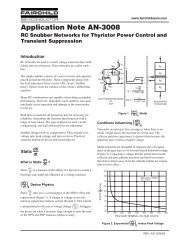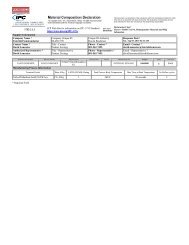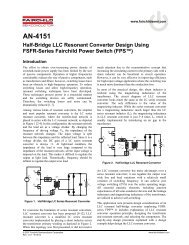AN-6094 Design Guideline for Flyback Charger Using FAN302HL/UL
AN-6094 Design Guideline for Flyback Charger Using FAN302HL/UL
AN-6094 Design Guideline for Flyback Charger Using FAN302HL/UL
Create successful ePaper yourself
Turn your PDF publications into a flip-book with our unique Google optimized e-Paper software.
<strong>AN</strong>-<strong>6094</strong><br />
t<br />
where tON is MOSFET conduction time minimum input<br />
voltage and maximum load condition, given as:<br />
ON<br />
2P<br />
L<br />
= (41)<br />
V f<br />
1<br />
min<br />
IN. T@Am DL S<br />
Secondary-Side Diode: The nominal reverse voltage of<br />
the diode is given in Equation (21).<br />
The rms current of the rectifier diode is obtained as:<br />
rms PK N t P DIS @ A ⋅ fS<br />
ID = IDS<br />
⋅ (42)<br />
N 3<br />
S<br />
(<strong>Design</strong> Example) The maximum voltage across the<br />
MOSFET is calculated as:<br />
max<br />
Vds max<br />
= VDL + VRO+ VOS = 373 + 71+ 155 = 599V<br />
The rms current though the MOSFET is:<br />
rms PK<br />
IDS = IDS tON fs<br />
3<br />
= 0.14A<br />
The diode voltage and current are obtained as:<br />
NS<br />
max 5<br />
VD = VO + VDL = 5 + ⋅ 373 = 33.1V<br />
NP<br />
66<br />
rms PK N tDIS @ A ⋅ f<br />
P<br />
S<br />
ID = IDS ⋅ = 2.14A<br />
N 3<br />
S<br />
[STEP-8] Determine the Output Filter Stage<br />
The peak-to-peak ripple of capacitor current is given as:<br />
N<br />
Δ I = I<br />
P PK<br />
C<br />
NS<br />
DS<br />
The voltage ripple on the output is given by:<br />
(43)<br />
N 2<br />
tDIS @ A ( ΔIC − IO<br />
)<br />
Δ VO = ⋅ +ΔIC ⋅RC<br />
(44)<br />
2CO<br />
ΔIC<br />
Sometimes it is impossible to meet the ripple specification<br />
with a single-output capacitor due to the high ESR of the<br />
electrolytic or tantalum capacitors. Additional LC filter<br />
stages (post filter) can be used. When using post filters, do<br />
not place the corner frequency too low. Too low corner<br />
frequency may make the system unstable or limit the<br />
control bandwidth. It is typical to set the corner frequency<br />
of the post filter at around 1/10~1/5 of the switching<br />
frequency.<br />
(<strong>Design</strong> Example) Assuming a 330 µF tantalum<br />
capacitor with 100 mΩ ESR <strong>for</strong> the output capacitor, the<br />
voltage ripple on the output is:<br />
NP<br />
PK<br />
Δ IC = IDS = 5.59A<br />
NS<br />
N 2<br />
tDIS @ A ( ΔIC − IO<br />
)<br />
Δ VO = ⋅ +ΔIC ⋅ RC = 0.592V<br />
2CO<br />
ΔIC<br />
Since the output voltage ripple exceeds the specification<br />
of 100 mV, a post LC filter should be used. Two 330 µF<br />
capacitors and one 1.8 µH inductor are selected <strong>for</strong> the<br />
post LC filter. Then, the cutoff frequency of the LC filter<br />
is 9.2 kHz.<br />
[STEP-9] Complete the RC Snubber <strong>Design</strong><br />
<strong>for</strong> the Diode<br />
When the primary-side MOSFET is turned on, severe<br />
voltage oscillation occurs across the secondary-side diode,<br />
as shown in Figure 19. This is caused by the oscillation<br />
between the diode parasitic capacitance (CD) and<br />
trans<strong>for</strong>mer secondary-side leakage inductance (LLKS). To<br />
reduce the oscillation, an RC snubber is typically used, as<br />
shown in Figure 19. To effectively introduce damping to<br />
the resonant circuit, the parameters of the RC snubber<br />
should be:<br />
LLKS<br />
RSNB<br />
= (45)<br />
C<br />
© 2012 Fairchild Semiconductor Corporation www.fairchildsemi.com<br />
Rev. 1.0.0 • 9/27/12 12<br />
D<br />
CSNB = 2~3times<br />
of CD<br />
(46)<br />
The secondary-side leakage inductance and the diode<br />
parasitic capacitance are difficult to measure with an LCR<br />
meter. The best way is to use a test capacitor across the<br />
diode. First, measure the natural resonance period (tR)<br />
without connecting anything to the diode. Then, add a test<br />
capacitor across the diode (CTST) such that the test<br />
resonance period (tRT) becomes about twice its original<br />
value and measure the test resonance period. With the<br />
measured tR, tRT, and CTST; the resonance parameters can<br />
be calculated as:<br />
t<br />
C = C − (47)<br />
L<br />
D<br />
RT 2<br />
TST /[( )<br />
tR<br />
1]<br />
LKS<br />
tR<br />
2 1<br />
( )<br />
2π<br />
CD<br />
= (48)<br />
2π LLKSCD Figure 19. Diode Voltage Wave<strong>for</strong>m








